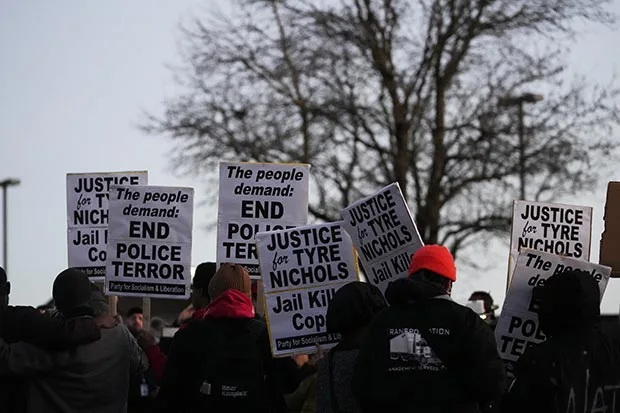When I heard about the Memphis police officers who beat a young black male (Tyre Nichols) to death, a popular nineteen-seventies pop song came to mind. The song carries the title of this column. It continues with lyrics like this: “And another one gone, and another one did, another one bites the dust.”
Look, “police killings “are nothing new. In the immortal words of a famous baseball player (Yogi Berra): “It’s like de-ja-vu all over again.” Just think of how many people were murdered when there weren’t any cameras around to record the incident(s). And they usually get away with it. From 1980 to 2019, only one percent were convicted for their harmful actions. They are hardly ever indicted, far less convicted. Listen, folks; no motorist -no matter what color, creed, race, ethnicity, religion, nationality, sexual orientation, gender identification, or whatnot- should be beaten to death over a broken car taillight or a speeding violation.
Maybe after living in New York City for more than forty years, I am accustomed to these types of reports; since right away, names like Eric Garner, Amadou Diallo, Antony Baez, Sean Bell, and Randy Evans jump up at me like basketball dunker. Even characters like Rodney King and Abner Louima – both of whom survived terrible police brutality incidents- have now become cliches. Louima had a toilet plunger shoved up his rectum and is permanently disabled. That incident cost NYC taxpayers at least seven million dollars. In this naked city, taxpayers dole out millions annually relative to police excesses and misbehavior. It is time for the government to mandate police officers have liability insurance when they are contracted. We all need insurance to drive an automobile anywhere legally. Policing is more intense and riskier than driving.
For those unfamiliar with the name “Randy Evans,” I suggest you do a “Google” search. This is one of the most fascinating cases I have ever encountered. It was one of those rare instances where in 1976, a New York City policeman (Robert Torsney) was charged with murder. His defense claimed that the officer was temporarily insane when he suffered a rare epileptic seizure. He incidentally discharged his weapon at point-blank range into the head of a fifteen-year-old black male high school student. Torsney’s medical records showed no evidence of such an incident before or after this shooting. A jury essentially let him walk away free. He was sent to a psychiatric institution (Creedmoor) in the city and was released in less than two years when a higher court found him not to be a threat to society. Go research this case for your edification.
The Institute of Health Metrics, located within The University of Washington’s Medical School, once studied the top 100 causes of death in the USA. Researchers used reports from doctors, medical examiners, and coroners to accumulate data. They discovered that ends at the hands of police officers turned up on this list: which included illnesses like cancer, strokes, and heart attacks. The study found that in the fifty years between 1980 and 2019, deaths at the hands of police officers totaled around thirty-one thousand. Of this number, they found that 9,540 were blacks. Thus the “racism aspect” as regards policing in the USA cannot be ignored: since blacks only make up roughly one-seventh of the country’s population. The victims’ ages ranged from three months to eighty-eight years; all races and ethnicities were among those who died at the hands of officers.
After a deep dive into this study, a few other troubling things were extrapolated. For example, blacks were nearly four times more likely to be killed in a police encounter when compared to whites, and from 1980 to 2019, these fatalities (overall) increased by thirty-eight percent. The arrest rate for police officers was found to be extraordinarily low. Even after conviction, sentencing was lenient. After being fired for misconduct, many officers moved to another jurisdiction and joined another police department. I am suggesting that there should be a national registry that traces the movement(s) of dismissed officers for misconduct. Those found guilty of felonies should be barred from ever serving in this capacity again.
It is exceedingly troubling about this Memphis case because the officers involved had turned off their bodycams and lied on their incident reports. Bodycams were meant to help in minimizing these types of events. There should be a penalty for turning off the body- cameras in the line of duty.
Apologists for police misconduct have highlighted that the officers involved in this event were of the same race as the victim. This tells me that racism isn’t the only reason behind police misconduct. All over the world, we find this phenomenon, especially in societies with less racial and ethnic diversity than the USA. It appears that the mentality of too many people undergoes rapid changes after joining police departments. They seem to be subsumed by “police-think,” wherein the vast powers they are given reach their zenith in their minds, and at times, they become prosecutor, judge, and jury when they perceive laws as having been broken.
One of my policy recommendations to police departments worldwide includes making mental health counseling mandatory for officers annually or semi-annually. Let mental health professionals perpetually evaluate them and their fitness for their role(s) in society. Just as it is mandated that cops go to the gun range at least bi-annually to demonstrate their fitness to carry a gun, so too should there be mental-health testing and evaluation(s).
Within the ranks of police officers, we can find high rates of alcoholism, drug use, and drug and spousal abuse. They also have high divorce rates and suicidal tendencies. It is a profession crying out for mental-health intervention(s).
Stay tuned in, folks.























































 and then
and then